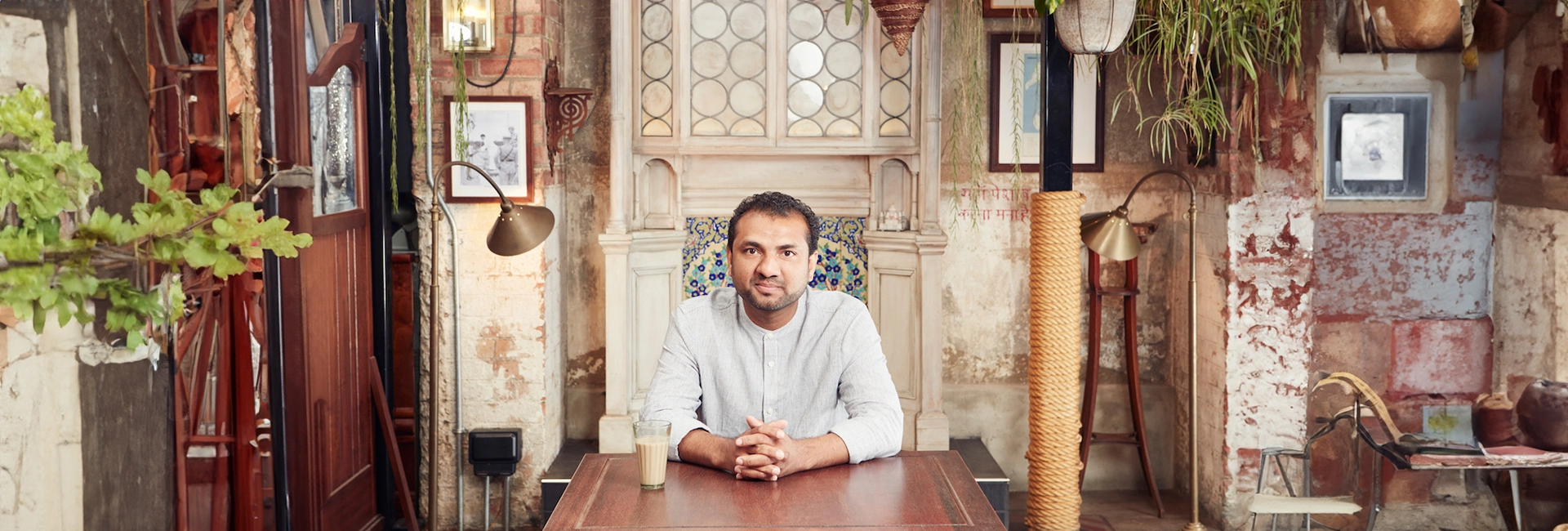(November 10, 2024) Ancient recipes, affordable street fare and his passion for authenticity define the food created by Chef Naved Nasir.
With a doctor father and a teacher mother, Naved Nasir was like every Indian kid, supposed to follow in his father’s footsteps, professionally. Destiny had other plans. His mother used to travel 80 km back and forth for her job, so he and his father would cook if she was short on time.
From the humble khichdi they made together to creating menus for a restaurant in Covent Garden in London, Chef Naved Nasir’s career trajectory is full of stories. These stories are of places lived, ingredients blended, and dishes had, at street corners, hole-in-the-wall cafés, and at his great-grandfather’s mansion. The nostalgia and love find their way into his food.
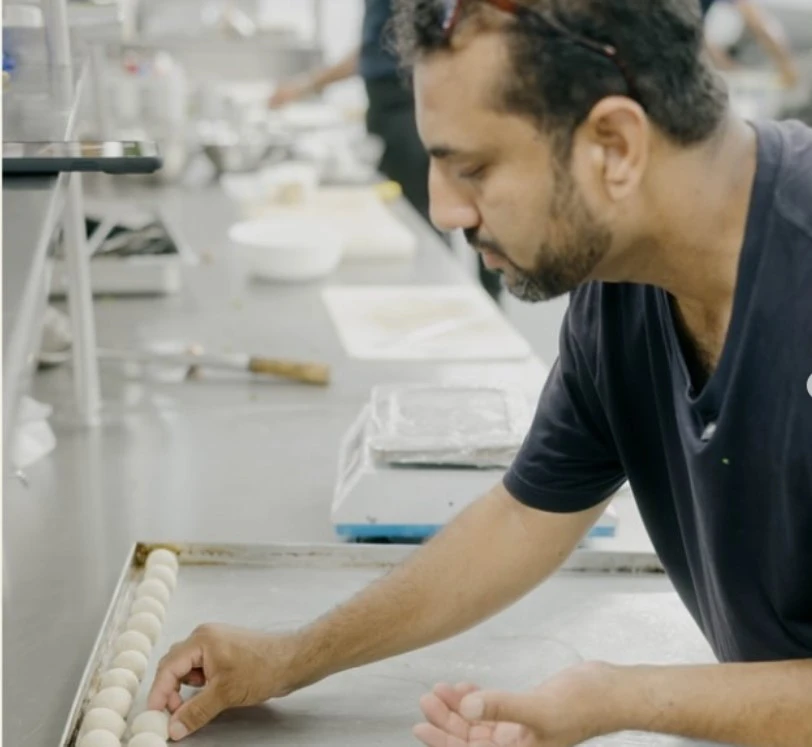
Chef Naved Nasir
History and food
Naved’s great-grandfather was a “minor nawab,” and the palatial family home still stands. Over a Zoom call, with Chef Naved in Dubai, while launching his restaurant Khadak, he recalls his earliest food influences. “I grew up in Meerut, Uttar Pradesh, and my grandfather’s home was 40 km away from Panipat, in Baghpat. As a child, I remember going there with my parents and brother, and watching my mother’s brother, who was quite a foodie, getting his staff to prepare the ingredients with so much care for the lavish dinners he’d host.”
He had ten cousins at home and remembers his mother’s Dal Gosht as her specialty. He says, “Whether it was the khansamas blending masalas or marinating the meat, or my father and I cooking khichdi when my mother was busy, it sparked an interest in food. My father, a doctor, had hopes I would also become one. I tried; I took the entrance exams for medicine at several universities, but I didn’t pass. At that time, due to all the celebrity chefs hosting TV shows, hospitality was gaining traction. I took the exam to join a catering college. It was relatively easier and I secured the eighth rank all-India.”
He joined the Institute of Hotel Management at Pusa, near Delhi. His first job as an intern was with the ITC group, where he worked in the kitchens of Dum Pukht, Bukhara, and Peshawri.
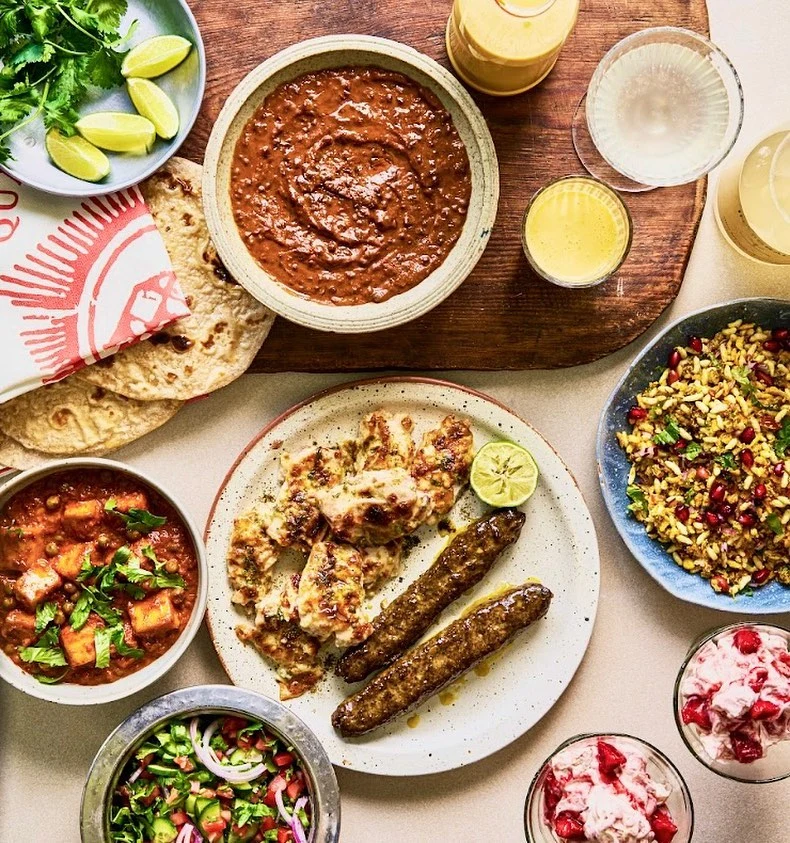
I love Bombay
Speaking of Mumbai, which he calls Bombay, Chef Naved waxes eloquent, much in love with the city he still considers home. He says, “Though I was in Mumbai for five or six years, it is the only city I consider home. I was 24 when I arrived there. I remember sitting on the ledge facing the sea at Marine Drive and crying because I felt lost. Mumbai put its arms around me in a giant hug and it became home. I used to go to the Irani cafés and other famous places like Bade Miyan, Olympia, Baghdadi and Kyani’s. These were places where you could have a lavish meal for a small amount.” Naved loved Mumbai so much that he would go there every weekend even after being transferred to the ITC Rama International in Aurangabad.
During his stint with ITC, from the start till he left, Chef Naved also got to serve and interact with several celebrities. Besides serving food to the Bachchans, planning the menu, and catering the food for the wedding of Rishi Kapoor’s daughter Riddhima. During the launch of their Jamnagar refinery, he also headed a team of 100 chefs to prepare the food for the Ambanis. He says, “We had several meetings with Neeta Ambani, and we sent three truckloads of ingredients to cater to the 600 guests. A separate Marwari caterer took care of the vegetarian fare, we were in charge of the rest.”
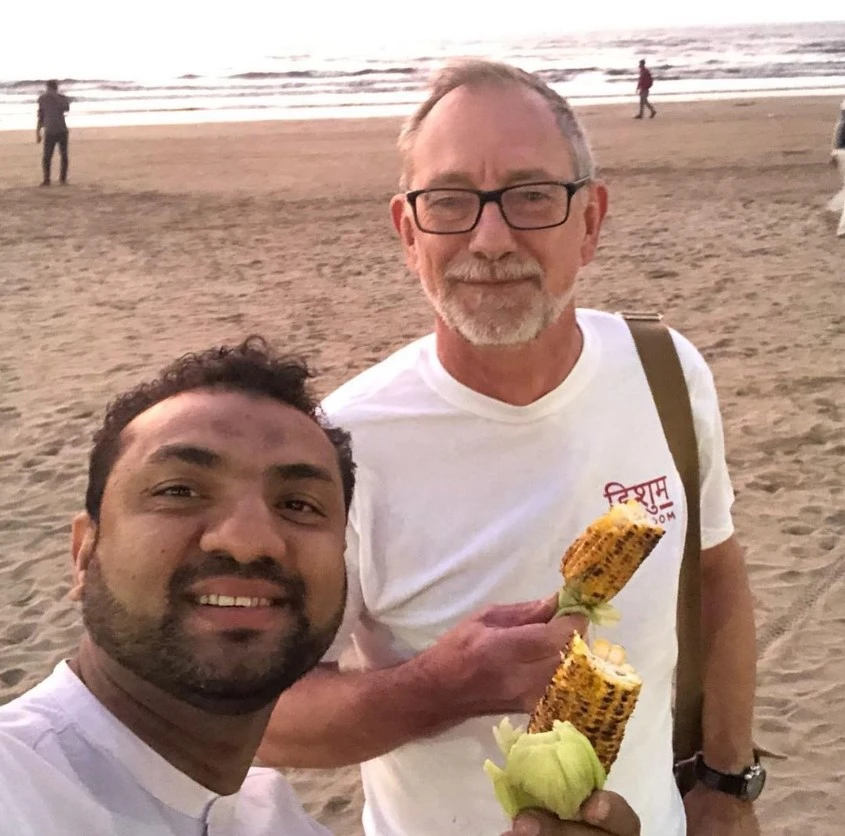
Chef Naved with Mike, the head of the build team of Dishoom Restaurants at a Mumbai beach
Namastey London
In Aurangabad, Naved was the youngest Executive Chef at 30. While he was there, he met the people who set up Dishoom in 2010. He recalls, “I met the owners and we were on the same page about keeping the food real. Shamil Thakrar and I had a similar outlook as he wanted a refined, authentic version of the Irani café food. If you go to London, between the small street eateries run by Bangladeshis and the Michelin-star restaurants, Indian food is unrecognisable. We wanted to fill the gap and my only condition was that there would be no adulteration. No toning down of the butter in Dal Makhni and reducing the spice in a chicken tikka. We did have options on the menu so for those who can’t eat spice, the Murgh Malai Tikka was a non-spicy option.”
Under the culinary leadership of Chef Naved, Dishoom expanded to ten locations across London. It filled a gap in the market; amidst exorbitantly expensive, quintessentially anglicised, or overly experimental Indian food establishments, the very first Dishoom set a new trend. Each restaurant has a theme based on the aesthetic of certain locations in Mumbai to complement and complete its gastronomy. He even co-wrote a cookbook by the same name.
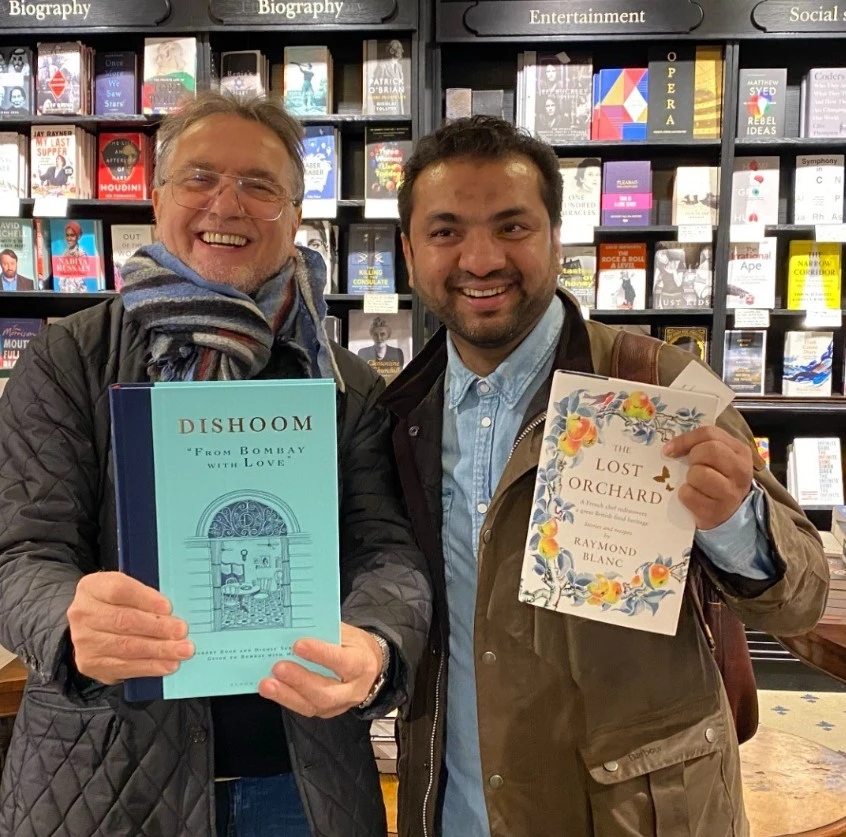
Chef Naved Nasir and Chef Raymond Blanc while signing each other’s cookbooks
After ten years with Dishoom however, Chef Naved started feeling the need to do his own thing; essentially to cook the Mumbai food he loved and more. The universe heard him and he got an offer to team up with a non-hospitality investor in Dubai. Enter Khadak, his new restaurant which was days away from its launch at the time of this interview.
Gully Boy
Having lived in multiple cities, Chef Naved Nasir delighted in those little bylanes peppered with food stalls known as khau gallis and people crowding around their periphery. These khau gallis are what Khadak is based on. Rather than sticking to a set pattern, he wanted to bring a selection of dishes from a range of backgrounds — truly a one-plate-fits-all. Again, Mumbai played a pivotal role in his new venture. Chef Naved reveals, “Khadak is an area at the far end of the lane near Suleiman Usman Bakery (a landmark on Mumbai’s Mohammed Ali Road, a major food hub, especially during the month of Ramzan). I plan to highlight all that Mumbai has to offer, beyond the swanky restaurants. From the Shammi Kababs to my mother’s Dal Gosht, to the food you get at Bade Miyan and Baghdadi and the recipes I have secured from my 91-year-old aunt, I want Khadak to take you back to authentic food. There are stories attached to these recipes and I intend to tell them through Khadak.”
The stories are told through a multitude of characters with backstories that are unique but relatable. Rajini, the Koli fisherwoman, for example. Along with highlighting her roots, Khadak talks about how the seas are facing the extinction of species and ecosystems, while parallelly supporting sustainable practices. Then there is Bittu, a kid doling out tea. Although appreciating his drive, Khadak encourages their patrons to donate to organisations that help children like him to get off the streets. Nasir is a firm believer that cuisines are not isolated from the people and civilisations they stem from.
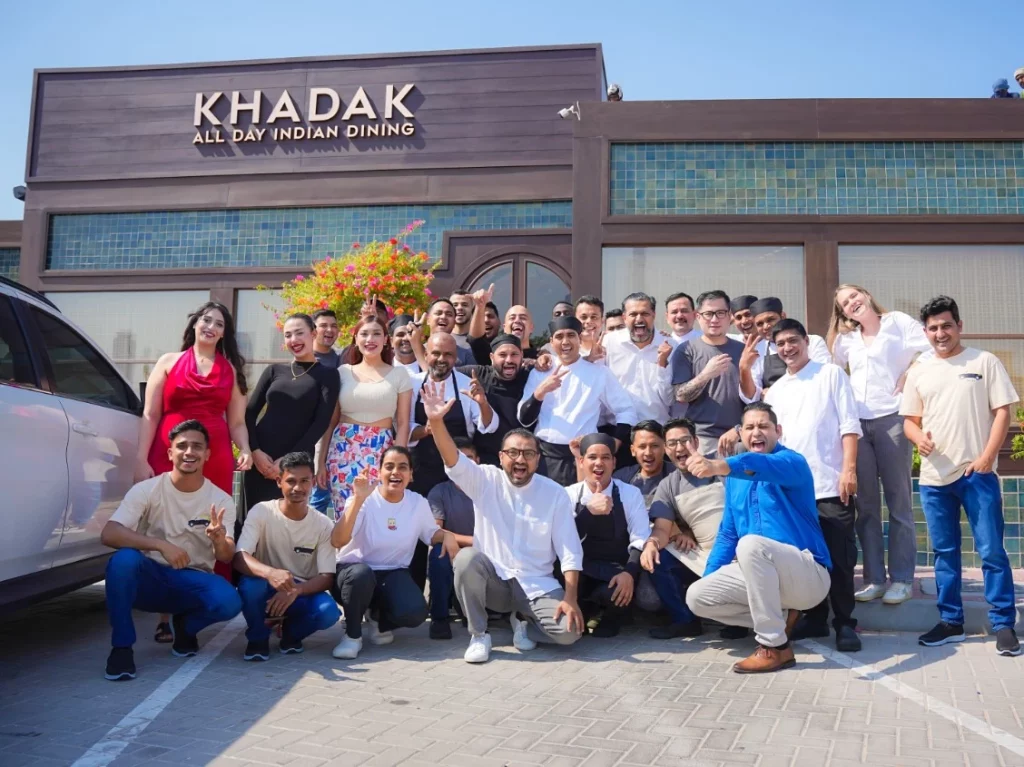
Naved with his team
Other dishes he plans to include are the Sojni ka Murgh, a Hyderabadi speciality where chicken is cooked with the pulp of drumsticks, Shabrati Nihari, a breakfast item where the meat just falls off the bone, and you eat it with a Lachha Naan sold in the bylanes of Delhi. He also has a vegetarian haleem on the menu made with jackfruit. Chef Naved is passionate about bringing these old stories to life, making them acceptable for the Instagram generation. Even desserts will be morphed. “The bread butter pudding, a family recipe from the Chilia community that our executive chef comes from, uses jaggery instead of sugar, and phirni is made vegan with cashew milk.”
Favourite go-to ingredients
Given the gamut of historical and ancient food at his disposal, what then are his favourite go-to ingredients? Chef Naved says, “I’d say meat is a favourite, because depending on the area of the body it is taken from, how it is cut, marinated and cooked, it tastes different. I even use the fat around the kidney when I cook, because it slices through like butter. Among spices, I like saffron for its subtlety and if you know how to use it, it can give diverse flavours. And lastly, an ingredient I like but am looking for a good quality one is gulab jal or rose water.”
With the spirit of Mumbai’s street food and ancient recipes from his family’s kitchens, Chef Naved could well be scripting food history and creating a legacy of Indian food soon.
- Chef Naved Nasir on Instagram
Read a similar story of Gaurav Chawla, surprises diners at Farzi Cafe, U.S.

